
Before the introduction of Vaccines, Measles was a common childhood illness that was not feared, but expected. More than 50% of the population was infected with the Measles between the ages of 5 and 9 and 90% got the Measles by age 15.
From 1953-1963, about 500,000 children got the Measles every year out of a population of 2.5 to 4 million who were susceptible. That is a 12.5 to 20% infection rate. Unfortunately, about 500 of those infected developed serious complications and died. However, that is only a 0.1% mortality rate. However, the U.S. Centers for Disease Control (CDC) says the death rate was even lower. According to the CDC, “Before the measles vaccination program started in 1963, about 3 to 4 million people got measles each year in the United States. Of those people, 400 to 500 died, 48,000 were hospitalized, and 4,000 developed encephalitis (brain swelling) from measles.” Using the CDC statistics, the death rate due to Measles was 500 out of 3 million Measles cases. That is only a 0.017% mortality rate!
In the past Measles was known to cause a typically mild, 9 day cold or flu-like illness and a rash. The disease was very contagious and bothersome, but in 99.9% of the cases, harmless, and provided life-long immunity to everyone infected, including young girls who would eventually become moms and pass that immunity on to their children to protect them while they are infants and still developing their immune systems.
Is it possible that this common child-hood illness provided a natural process of immune challenge and development to prepare it for more serious challenges.
Mass Vaccination Programs are Creating New Epidemics
The current Measles Mass Vaccination Programs around the world have pushed the susceptible age down to the youngest and most vulnerable, under the age of one. At the same time the Measles vaccine has extended the upper age of susceptibility above age 20 when the down time is much more costly and potentially harmful and the contagious spread of infection is inherently much more expansive.
We are now beginning to see a new epidemic of Measles affecting those who have been previously vaccinated, because the vaccine did not confer immunity, the immunity wore off, or the Measles virus has mutated sufficiently so that it is no longer recognized as the same virus.
Would we not be much wiser to focus our resources in augmenting the nutrition and immunity of the 0.1% or less of the population that gets the serious complications of Measles rather than forcing the 99.9% of the healthy population to get vaccines that pose serious additional risk, including seizures, encephalitis and death?
Vitamin A Reduces Measles Mortality by 82%
By prescribing one simple vitamin (200,000 IU of Vitamin A) on two consecutive days, it has been shown that we can reduce the risk of death due to Measles by 82% (RR 0.18; 95% CI 0.03 to 0.61) and the risk of pneumonia-specific mortality from Measles by 67% (RR 0.33; 95% CI 0.08 to 0.92) at a cost of $2.50 per person verses $104.00 per person for 2 doses of the MMR Vaccine. Vitamin A for treating measles in children. [Cochrane Database Syst Rev. 2002;(1):CD001479]
If the U.S. Health Department had instituted “Mass Vitamin A Programs” instead of “Mass Vaccination Programs,” the death toll for Measles would have dropped by 82%, from 500 children annually to only 90, leading to a 0.003% mortality rate. If this one simple program had been instituted instead of vaccinations, it would have protected 99.997% of the population from dying from Measles and allowed everyone else to acquire permanent immunity, which moms could then pass on to their infants and Measles would still be a common, mild infection that would occur only in children between the ages of 5-15 years.
Man should not pretend to play God. We cannot eliminate every virus and we cannot eliminate all suffering. Man’s ways are not God’s ways, and God is wiser than man.
If Vaccination Programs were proven to be safe and effective they would be welcomed, but they are not. Common side effects from the MMR vaccine include low-grade fever, skin rash, itching, hives, swelling, reddening of the skin, and weakness. Additional reactions include thrombocytopenia, or extremely low platelet levels that can lead to internal bleeding; joint, muscle and nerve pain; gastrointestinal disorders; measles like rash and conjunctivitis. Serious adverse reactions include seizures, brain inflammation, encephalopathy and death.
Because Vaccines can and do cause seizures, encephalitis, permanent brain damage and death, parents must be given all the facts and the right to choose whether or not to vaccinate their children. In order to make an informed and decision, parents need to know the facts and the alternatives and because this is a Judeo-Christian nation, many will want to give this issue serious prayerful consideration. Some of us still believe, “In God we trust.” I believe parents have the God given right to decide what is best for their children. They may have parental inspiration that is specific to their child that could save that child’s life, whether to give or not give that child vaccines.
Measles Overview
- Measles is a common childhood illness
- Before Vaccines 90% of population got them and 99.9% recovered completely
- 500,000+ people got it every year in the U.S. before 1963
- Only 12.5-20% of the susceptible get Measles when exposed, NOT 90%
- Only 0.1% or fewer die from Measles, usually those with compromised health
- Measles typically causes a mild 9 day Viral Infection and Rash
- Natural Measles Infection gives permanent life-long immunity
- Natural infection in Moms gives newborns prolonged protection
- Before Vaccines it was rare for a child under 5 yrs old to get Measles
- Now babies are born without maternal antibodies and are most vulnerable
- Infants vaccinated at less than 1 year do not develop sustained antibodies
- Many adults over age 20 who were vaccinated have lost their immunity and are getting Measles again
- Adults who get Measles a second time often get a more severe type of Measles
- It is impossible to control or circumvent nature without causing serious side-effects
- Measles Vaccines can cause convulsions, seizures, encephalitis and death
- Improved Hygiene & Nutrition caused the greatest decline in Measles not Vaccines
- There is a proven treatment for Measles: Vitamin A reduces death rate by 82%
Historical Facts About Measles
Before 1963, when Measles vaccines were first instituted, Measles was a “Common Childhood Illness.” It is a highly contagious but seasonal, typically mild to moderate viral infection that occurs in the U.S. and globally in cyclical “waves” which wax and wane in numbers every two to three years.[15],[16],[17]
More than 50% of all Americans got the Measles by age 6, and more than 90% got the Measles by age 15. The highest incidence was among 5–9 year-olds, who generally accounted for more than 50% of reported cases.
The statement that “If you are exposed to Measles there is a 90% chance that you will get it unless you are already immune,” is inaccurate and misleading. The 90% statistic applies to a lifetime of exposure not one single exposure.
Prior to 1912, Measles was not a reportable disease in the U.S., so accurate numbers of cases are not available prior to that time. Before routine vaccinations, 2.5 to 4 million Americans were exposed to the Measles every year, approximately 500,000 individuals got infected (12.5 to 20% of the susceptible individuals) and about 500 died (0.1% of those infected).
The CDC likes to show the the graph below, which makes the drop in reported measles cases and deaths in the U.S. beginning in 1965 to appear much more dramatic than the larger historical graph below it. However, published Measles morbidity and mortality data show that the death rates for Measles had already dropped by 40-45% in the U.S. before the measles vaccine was introduced in 1963. [27], [28]
Measles – United States, 1950-2009

In 1941, there were 894,134 cases of Measles reported in the United States.[18] . Through improved sanitation and nutrition, from 1942 to 1962, the number of deaths dropped significantly to 432 deaths in an average of 503,282 cases of Measles per year (0.085% or 85 deaths per 100,000 cases).
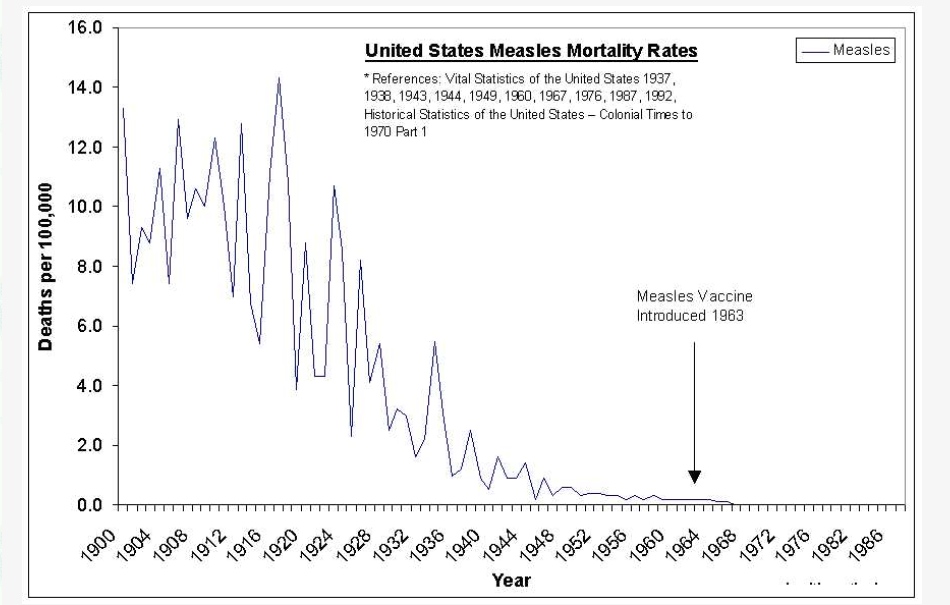
More recent Measles cases in the U.S. can be observed by looking at the CDC’s Notifiable Diseases and Mortality Tables:[24]
• In 2007 there were 43 cases
• In 2008 there were 140 cases
• In 2009 there were 71 cases
• In 2010 there were 63 cases
• In 2011 there were 217 cases
• In 2012 there were 55 cases
• In 2013 there were 189 cases
• In 2014 there were 644 cases
The CDC reports no Deaths due to Measles in the past 20+ years!
In 2014, 67% of the Measles cases reported in California occurred in previously vaccinated adults. Currently there is growing media hysteria blaming unvaccinated individuals as the reason for the current rise in Measles. This is not scientifically validated, but merely speculation and conjecture.
On January 21, 2015, the California Department of Public Health announced, “that local public health officials have confirmed a total of 59 cases of measles in California residents since the end of December 2014. Patients range in age from 7 months to 70 years. Vaccination status is documented for 34 of the 59 cases. Of the 34 with known vaccination status, 28 were unvaccinated, one had received one dose and five had received two or more doses of MMR vaccine.” These numbers mean that between at least 10% and as many as 53% of Measles cases were vaccinated and 47% were unvaccinated.
2015 Measles Outbreak at Disneyland
Age Distribution of California Confirmed Cases as of January 22, 2015
| Age (Years)* | No Known Link to Disneyland (N) | Linked to Disney (N) | Total, N | Total, (%) |
| <1 | 0 | 4 | 4 | 5% |
| 1-4 | 2 | 9 | 11 | 14% |
| 5-19 | 3 | 12 | 15 | 19% |
| >20 | 21 | 26 | 47 | 61% |
| Total | 26 | 51 | 77 | 100% |
* Two cases have missing age data.
The real alarm here is that 61% of the Measles cases so far this year are in people over age 20. Measles used to be a common, mild, childhood infection. It now morphing into a disease that affects young adults and adults aged 20 and older.
Vaccines work but Are they Worth the Risks?
Before the advent of Vaccines, the typical age for getting the Measles was 5-15. Then, a generation ago, doctors routinely began vaccinating every child against Measles, beginning at 15 months. No one worried much about what would happen when they grew up and had babies of their own.
Since the vaccine provides only temporary and weaker immunity than does the immunity derived from a natural infection, new mothers have little or no maternal antibodies to pass along to their newborn babies through the placenta.
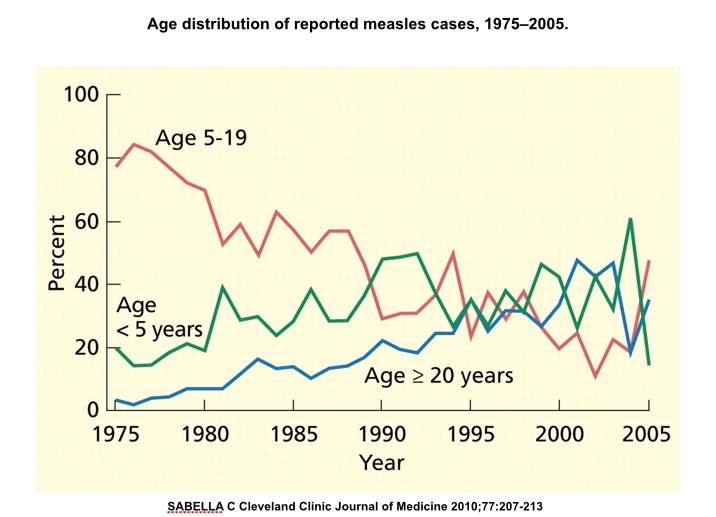 The result is a new problem: Measles infections are now affecting the very young, including at least 12-28% of children under 1 year of age, who are now getting infected when they are the most vulnerable.
The result is a new problem: Measles infections are now affecting the very young, including at least 12-28% of children under 1 year of age, who are now getting infected when they are the most vulnerable.
The response from the CDC is to give the vaccine at a younger and younger age, when the immune system is much less able to deal with the virus or toxins in the vaccine and it causes greater risk and weaker or shorter immunity.
According to the Merck MMR II Vaccine insert for Physicians, “There is some evidence to suggest that infants immunized at less than one year of age may not develop sustained antibody levels when later re-immunized. The advantage of early protection must be weighed against the chance for failure to respond adequately on re-immunization.”
CDC figures show that this has actually changed the face of Measles. In 1976, just 3% of all Measles cases occurred in children under age one. Typically their mothers were born in the 1950’s, well before the Measles vaccine became routinely available a decade later.
In the 1980’s, as young women who were vaccinated as children began to have babies, those numbers started to change. In 1985, almost 8% of Measles cases were in infants under age 1. By 1991, it had climbed to 19%, and one year later in 1992, 28% of all measles cases occurred in babies under 1 year of age.
The truth is Nature is still wiser than man. The natural life cycle of the common childhood illnesses before the introduction of vaccines provided sequential immune challenges between the ages of 5 to 15 that allowed children to develop immunity at the optimum immune age.
Vaccines have now created an exceptionally toxic challenge that is administered way too early, that wears off after 10-30 years and leaves the individual vulnerable to more serious disease.
New Epidemic? Measles in Vaccinated Adults
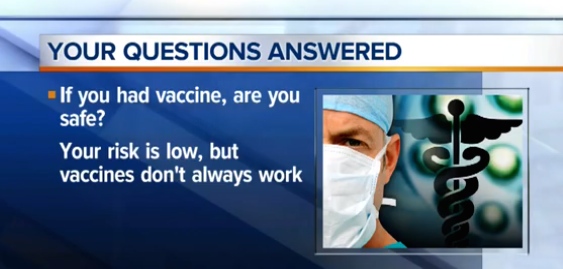
Over the last several years we have begun to see another worrisome new development in the changing face of Measles since the advent of Vaccines. More and more adults are now getting Measles. Vaccines do not always work and they only provide temporary immunity that is weaker than that conferred by a natural infection.
What happens when the temporary immunity wears off. In 2014, in California, 33 of the 49, or 67%, of all Measles cases reported occurred in previously vaccinated adults.
Colleges are now requiring all students to get an additional Measles vaccine dose before starting their freshman year if they cannot prove they have had two doses or are immune, because the vaccine wears off, but no one really knows how additional doses of this vaccine might affect them later in life. Every student who gets additional doses of the Measles vaccine is part of a new clinical study. The benefits and the risks are completely unknown.
The Measles vaccine (MMR) is required vaccination at ASU and other state colleges. Students are required to document that they have had two Measles vaccinations (one of which must be dated after 1979), or a lab test showing proof of immunity to the Measles (Rubeola).
Vaccinated vs Unvaccinated: Who’s Healthier?
In December 2010, a survey was initiated by VaccineInjury.info to compare the health of vaccinated children with unvaccinated children. The survey is ongoing, so if you would like to participate, you can. Though this is obviously not a double-blind controlled study, and depends on the individuals submitting the data to give accurate information, it is still revealing. At the time of this writing, the results show:
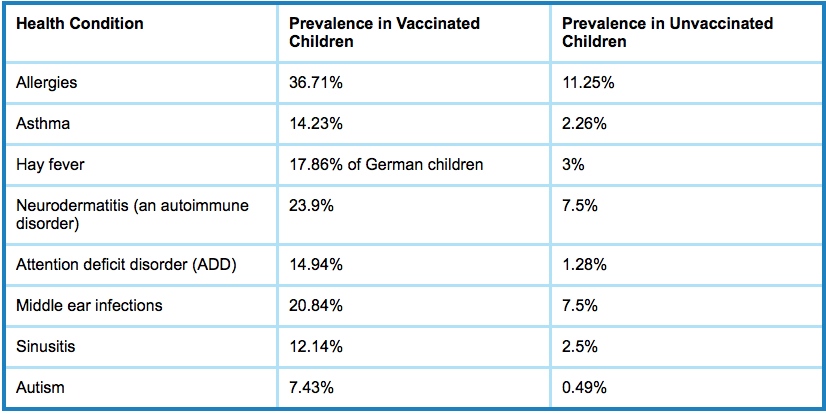
Can Measles Cause Injury & Death?
In 90-99% of all those infected, Measles is a 9 day cold or flu like illness that includes a rash on the 4th day. The incubation period ranges from 7 to 14 days from exposure to onset of fever; rash usually appears about 14 days after exposure. 99.9% of all those infected recover completely without any residual harm but lifelong immunity.
Prodromal symptoms include fever between 101-104°F (40.6°C), conjunctivitis (red eye mucous membranes), runny nose, cough, and small spots with white centers on a red base on the inside of the cheeks (Koplik spots).
The rash is a characteristic red, flat or raised rash that appears on the third to fourth day after the prodromal symptoms appear. The rash begins on the face, becomes generalized, and lasts 4–7 days.
Measles complications can include diarrhea (8%), middle ear infection (7–9%), and pneumonia (1–6%). Encephalitis, which can result in permanent brain damage, occurs rarely, in approximately 0.1% of Measles cases. Although Measles can cause death, there are no reported deaths from Measles in the last 20 years.
In pregnant women, Measles can also cause rare cases of miscarriage, or cause the mother to give birth prematurely, or to have a low-birth-weight baby. [33],[34]
Can Measles Vaccine Cause Injury & Death?
Common side effects from the MMR vaccine include low-grade fever, skin rash, itching, hives, swelling, reddening of skin, and weakness.
Serious adverse events following MMR vaccination include seizures, severe headaches, double vision, vomiting, joint pain, or pain in the digestive system.[75]
Other more rare but serious complications reported by Merck in MMR vaccine post-marketing surveillance include:[76]
• brain inflammation (encephalitis) and encephalopathy (chronic brain dysfunction);
• panniculitis (inflammation of the fat layer under the skin);
• syncope (sudden loss of consciousness, fainting);
• vasculitis (inflammation of the blood vessels);
• pancreatitis (inflammation of the pancreas);
• diabetes mellitus;
• thrombocytopenia purpura (blood disorder);
• leukocytosis (high white blood cell count);
• anaphylaxis (shock);
• bronchial spasms;
• arthritis and arthralgia (joint pain);
• myalgia (muscle pain);
• polyneuritis (inflammation of several nerves simultaneously).
According to MedAlerts.org, which facilitates an online search of the federal Vaccine Adverse Events Reporting System (VAERS) database, shows that as of July 9, 2012, there have been 6,058 serious adverse events reported to VAERS after inoculation with an MMR vaccine since 1990, when the system began. Half of the adverse events reported occurred in children aged 3 years of age and younger. These adverse events following MMR vaccination reported to VAERS include:
• aseptic meningitis (inflammation of the lining of the brain);
• deafness;
• cardiomyopathy (weakening of the heart muscle);
• hypotonic-hyporesponsive episodes (collapse/shock);
• ataxia (loss of ability to coordinate muscle movements);
• paresthesia (numbness, burning, prickling, itching, tingling skins sensation indicating nerve irritation)
• lupus (autoimmune connective tissue disorder);
• Guillain-Barre syndrome (inflammation of the nerves);
• encephalitis;
• convulsions;
• subacute sclerosing panencephalitis (SSPE);
• autism?
• death
There have also been 288 deaths reported to VAERS in association with the MMR vaccine. That equals approximately 12 deaths per year since 1990. However, the numbers of vaccine-related injuries and deaths reported to VAERS may not reflect the true number of serious health problems that develop after the MMR vaccination due to under reporting by parents who are told by their doctors that the vaccine was not the cause of the adverse event.
Even though the National Childhood Vaccine Injury Act of 1986 legally required pediatricians and other vaccine providers to report serious health problems following vaccination to federal health agencies (VAERS), many doctors and other medical workers giving vaccines to children and adults fail to report vaccine-related health problems to VAERS. There is evidence that only between 1-10% of serious adverse health problems that occur due to prescription drugs and vaccines in the U.S. are ever reported to federal health officials, who are responsible for regulating the safety of drugs and vaccines and issue national vaccine policy recommendations.[78][79][80][81]
There have been 6,058 serious adverse events reported to the Vaccine Adverse Events Reporting System (VAERS) in connection with the Measles vaccine since 1990, with over half of those occurring in children 3 and under.
As of March 1, 2012, there have been 898 claims filed so far in the Federal Vaccine Injury Compensation Program (VICP) for 56 deaths and 842 injuries that occurred after MMR vaccination.
Use of Mercury in Vaccines
Over the past 28 years, I have joined with many health experts around the world and spent countless hours researching, writing and testifying before the House and Senate to pressure the FDA and the Vaccine Manufacturers to make safer vaccines and to keep parental choice a valid exception to mandatory mass vaccination programs.
Thimerosal is a mercury-containing organic compound (an organomercurial). Since the 1930s, it has been widely used as a preservative in a number of biological and drug products, including many vaccines, to allegedly help prevent potentially life threatening contamination with harmful microbes.
Over the past several years, because of an increasing awareness of the theoretical potential for neurotoxicity of even low levels of organomercurials and because of the increased number of thimerosal containing vaccines that had been added to the infant immunization schedule, concerns about the use of thimerosal in vaccines and other products have been raised.
Indeed, because of these concerns, the Food and Drug Administration has worked with, and continues to work with, vaccine manufacturers to get them to reduce or eliminate thimerosal from vaccines. (Source: FDA:)
Because of these efforts Thimerosal and other mercury products have been removed from or reduced to trace amounts in all vaccines routinely recommended for children 6 years of age and younger, with the exception of most commonly given influenza vaccine.
A preservative-free version of the inactivated influenza vaccine, which still contains trace amounts of thimerosal, is available in limited supply at this time for use in infants, children and pregnant women.
Some vaccines such as Tetnus diphtheria (Td), which is indicated for older children (≥ 7 years of age) and adults, are also now available in formulations that are free of thimerosal or contain only trace amounts. Vaccines with trace amounts of thimerosal contain 1 microgram or less of mercury per dose.
Even these trace amounts are considered excessive and I will continue to push for the elimination of this neurotoxin as well as all of the other toxic materials included in vaccines, including Aluminum, Formaldehyde (a know carcinogen), the detergent octoxynol-10 (TRITON®X-100), Polysorbate 80, etc.
Could the Measles Vaccine be a Cause of ADHD
Measles virus has been demonstrated in brain tissue biopsies in patients with Subacute Sclerosing Panencephalitis (SSPE). Some experts believe that an altered measles virus, which could be derived from the Measles vaccine, is the probable cause of this progressive, usually fatal neurologic (brain) disorder that can occur months or years after the initial vaccination or possibly a natural Measles infection.
The first symptoms of SSPE and ADHD are remarkably similar and include diminished performance in schoolwork, forgetfulness, temper outbursts, distractibility, sleeplessness, hallucinations, mild and severe seizures. Is it possible that ADHD is a mild form of chronic SSPE caused by the Measles vaccine? Is it possible that the Measles vaccine is the principal cause of the epidemic of ADHD that we have seen in school children since the mid 1960’s to early 1970’s?
Adverse Vaccine Reaction Reports
This section contains a sample of a few of the unsolicited adverse reaction reports associated with the MMR vaccine. They are typical of the daily emails received by the Thinktwice Global Vaccine Institute.(14) Additional reaction reports associated with MMR may be found in the sections on measles, mumps, rubella, autism, and multiple inoculations.
[MMR114] My 12-month-old received his MMR shot on a Friday. The following Friday he had a 104 degree temperature and became violently ill. The doctor said it was a stomach virus. But on Monday morning he woke up with a rash all over. I took him to the doctor and was very upset to learn that this is very common.
[MMR128] Recently, my 13-month-old had his MMR. He now has constant high fevers and seizures, which he never had. He is a totally different boy. This is devastating.
[MMR176] My friend’s 15-month-old daughter received an MMR vaccine. Within eight days she was hospitalized with a 104 degree fever and a skin rash. My friend called to see what I could find out about Stevens-Johnson syndrome. They told her that her daughter may die as a result of this.
[MMR203] A dear friend lost her 15-month old daughter two weeks after her MMR. She was healthy and showed no signs of illness yet died suddenly in her sleep one afternoon. The post mortem revealed a viral infection and traces of pneumonia, but her mother and I find it very hard to believe that the vaccination wasn’t to blame.
[MMR216] Three days ago my friend’s 15-month-old daughter was hospitalized after experiencing a high fever and her first seizure. The hospital put the baby through a series of tests, including a CAT scan and CBC. My friend told me he thought it was a reaction to the MMR vaccine she recently received. However, the doctors were puzzled as to the cause and disallowed this explanation.
[MMR315] When my daughter was just over one year old, she received her MMR vaccination. Later that day she had a high fever, and I put her to bed. I was busy doing housework downstairs and got this “mother’s intuition” that something was wrong. I rushed upstairs to find her blue and not breathing. I called a nurse. My daughter seemed to be convulsing, so I was instructed to reach down her throat to open her air passage. She was rushed to the hospital and they immediately put her into a cool bath. She was in the hospital for almost a week. Had it not been for my gut feeling that something was wrong, my baby would not be with me today.
[MMR317] Our son developed seizures after his MMR vaccine at 14 months. Today, after two years of anti-epilepsy medications, he has totally regressed. We decided to stop all medications five weeks ago and his grand mal fits have stopped. We are now left with a child experiencing severe constipation and bowel problems.
[MMR321] One week after the MMR shot for my 16-month-old daughter, she had diarrhea. The next day she had three seizures. What steps should be taken once a reaction has occurred. I want to be sure it is documented and the government is made aware.
[MMR398] My daughter had a serious reaction to the MMR shot when she was 22 months. She developed brain damage after a fever of 106 degrees. She also has seizures which are unresponsive to medication, damage to the nerves of her eyes, and learning disabilities that she battles every day. We took her case to court and lost. The
doctor who testified on their behalf stated that the government only called him in when they wanted a finding in their favor. What a setup! Of course they don’t have to live with the frustrations and expense of raising these vaccine damaged children.
Natural Measles Treatment with Vitamin A
The most effective treatment for preventing the most serious consequences of the Measles is the supplementation of Vitamin A. Although the CDC and Public Health Officials never seem to mention this simple remedy, it has been used with astounding benefits around the world.
Naturopathic Physicians, as well as The World Health Organization and the American Academy of Pediatrics recommends Vitamin A for all children with acute measles, regardless of their country of residence, to reduce the risk of complications. Vitamin A is a necessary substrate for preserving epithelial cell integrity and in addition plays a major role in immune enhancement.
Using two doses of Vitamin A (200,000 IU) on consecutive days has been shown to be associated with a 82% reduction in the risk of mortality in children under the age of two years (RR 0.18; 95% CI 0.03 to 0.61) and a 67% reduction in the risk of pneumonia-specific mortality (RR 0.33; 95% CI 0.08 to 0.92).
Source: Vitamin A for treating measles in children. Cochrane Database Syst Rev. 2005 Oct 19;(4):CD001479. American Academy of Pediatrics
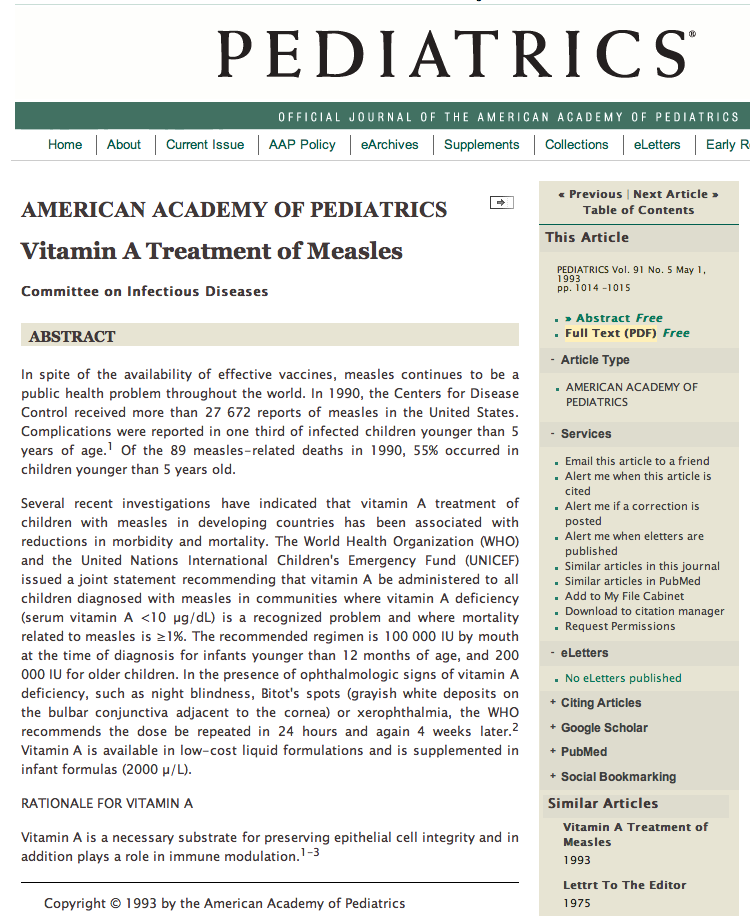
Vitamin A should be administered once a day for 2 days at the following doses:
• 50,000 IU for infants aged <6 months
• 100,000 IU for infants aged 6–11 months
• 200,000 IU for children aged ≥12 months
An additional (third) age-specific dose of vitamin A should be given 2–4 weeks later to children with clinical signs and symptoms of vitamin A deficiency. Parenteral and oral formulations of vitamin A are available in the United States. (Source: CDC, updated 12/13/13)
Summary
Before the introduction of Vaccines in 1963, Measles was a common mild childhood illness that infected 90% of all children ages 5-15, with a low death rate, from which 99.9% of the population recovered completely and from which they gained strong life-long immunity.
Although Vaccines have reduced the incidence of Measles infections, they have created a much more serious vulnerability in the very young and a new threat of significant outbreaks in adults whose immunity has worn off.
Mass vaccination programs may only represent a short-sighted effort to shortcut nature. Vaccinations are, at best, an artificial copy of a natural process that nature can always do better than man. Would we not be wiser to spend more time and money, and effort in observing nature and in seeking to assist the body’s natural immunity?

